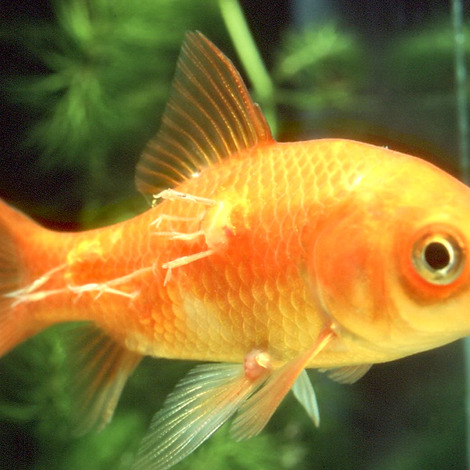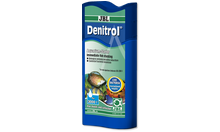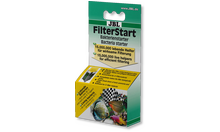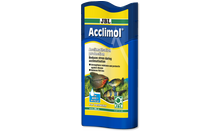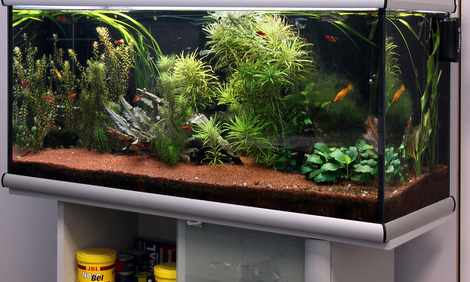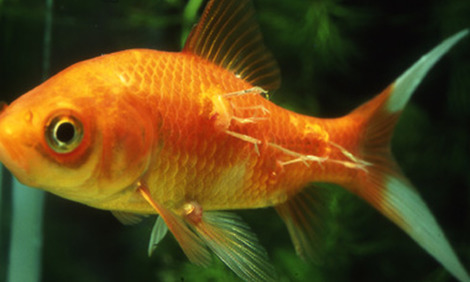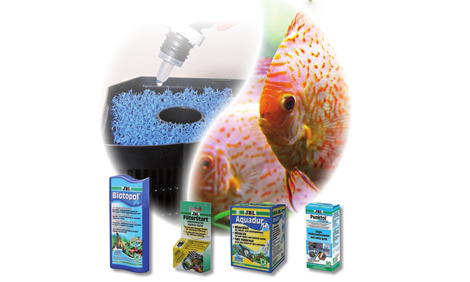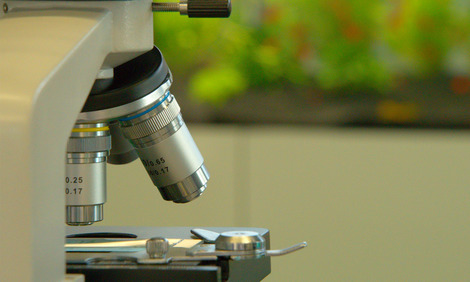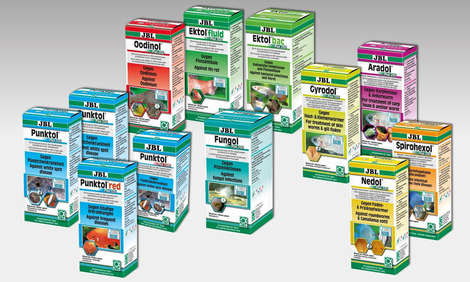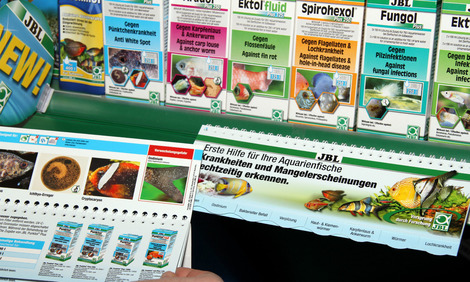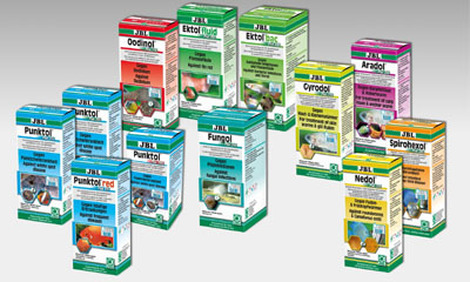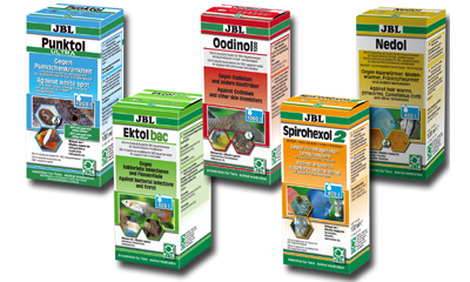About 90 % of all fish diseases can be put down to a weakening of the fish’s immune system. This means the application of remedies can fight the pathogen but doesn’t generally eliminate the cause. It is therefore very important to determine the cause.
Lernaea, anchor worm, Copepodes:
Although this parasite, which can grow to about 20 mm long, is termed a „worm“, it belongs to the genus of crustaceans. It tends to be found in ponds and less often in aquariums, but when this is the case it is on imported wild fish or offspring from field facilities. The juvenile stages of these parasites can survive for about 5 days without a host. With JBL Aradol Plus 250 (aquarium) and JBL ArguPond Plus (pond) it is simple, quick and safe to control. The infection with Lernaea crustaceans weakens the host fish and harbours the risk of a secondary fungal or bacterial infection. Please therefore observe the animals after treatment to check that the wounds are healing properly.
The removal of the crab with tweezers is often recommended, but this is not advisable, as the head of the crab is deeply embedded in the fish and stays in the fish when part of the crab is torn off. This then results in poisoning from foreign protein.
Carp louse, Argulus:
The carp louse Argulus is easy to detect on affected fish. It is a parasite; it can grow up to more than one centimetre long, and has a round, flattened body. The carp louse belongs to the fish lice (brachiura) with about 70 crustacean species which live parasitically. They bore into the fish’s flesh to suck blood. Inflammations and infections can arise from the bite. If heavily infested, the fish will also lose weight.
Carp lice occur primarily in ponds, but occasionally also in warm water aquarium fish, and when they do it is on imported wild fish or offspring from field facilities.
Products & Shop
JBL Aradol Plus 250
Remedy against carp lice and anchor worms in aquarium fish
- Combats carb lice, anchor worms, gill maggots and wood lice. Does not work under 18 °C
- For the treatment of parasites on freshwater and marine fish. Not suitable for aquatic invertebrates!
- The remedy does not kill the parasite but prevents it reproducing. Pathogen then dies.
- JBL Online Hospital: gives you access to identify fish diseases
- Contents: 1 package of Aradol Plus 250, 100 ml. Suitable for aquariums of max. 500 l. For repeated use for max. 250 l. To use: 1st day: 10 ml/50 l water. 8th day: 50% water change. 14th day: 10 ml/50 l water
You may also be interested in
JBL Aradol Plus 250 100 ml
Properties
| Animal species: | Arowana, Axolotl, Barbels, Bettas, Bichirs/reedfish, Blowfish, Catfish, Cichlids (South America), Crayfish, Danions, Discus, Dwarf shrimps, Flowerhorn, Gobies, Goldfish, Gouramis, Guppy, Juvenile fish, Killifish, Livebearers, Loaches, Panchaxes, Rainbowfish, Spiny eels, Tetra, Veiltails, freshwater butterflyfish |
| Animal size: | For all animal sizes |
| Animal age group: | All aquarium fish |
| Volume habitat: | > 500 L |
| Material: | Diflubenzuron, polyethylene glycol, sodium salt of carboxymethyl cellulose, purified water |
| Colour: | white |
| Dosage: | 100 ml suspension as a supplement for 500 l aquarium water |
| Transport conditions: | For this type of product we recommend transport and storage at room temperature. |
Electronic label / illuminant
| Mercury: | No |
| Dimmable: | No |
Technical Data
| Height: | 125 mm |
| Length: | 60 mm |
| Width: | 30 mm |
Unless otherwise indicated in the instructions for use, the simultaneous use of two different medications is not possible and we strongly advise against it. Toxic cross reactions and undesirable side effects, such as oxygen deficiency or nitrite, cannot be ruled out. If your fish suffer from a primary infection and further secondary infections, always treat the primary infection or disease with the highest stress factor for the animal. Finish a treatment with the correct dosage in accordance with the instructions and then start the second medication. After the treatment or between two treatments, filter the aquarium water over activated carbon for 24 hours to remove any residual medication. The activated carbon need then to be disposed of properly. Any medical treatment is also a stress factor for your fish, so be careful not to overburden your animals and only treat them after a thorough diagnosis.
No, the active substance is not effective against worms from the group of the annelid worms, to which fish leech belong.
No. As a rule, over-the-counter medications for ornamental fish may not be used in fish that are bred for human consumption.
JBL Aradol has no specific effect on planarias, although positive effects may occur occasionally. However, JBL Aradol should not be used against planarias in combination with shrimp, as this would require higher doses. We are not aware of any cases of sensitivity to JBL Aradol in freshwater snails.
Can I use JBL Aradol if I have shrimp in my tank?
JBL Aradol is not suited for shrimp. This is due to the fact that the active ingredient is a so-called chitin synthesis inhibitor, i.e. it inhibits shell formation in all crustacean-like animals (and others which also use chitin as a component in their skin, such as some roundworms and/or flatworms). Corresponding information is included with the package insert.


